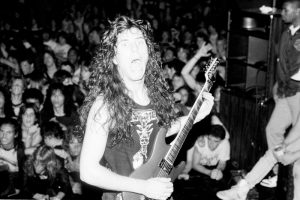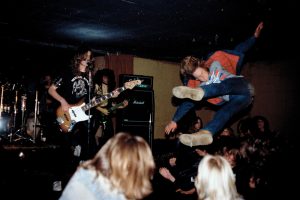‘Murder in the Front Row’ documentary celebrates Bay Area thrash
I
Images courtesy “Murder in the Front Row.”Decades after their release, countless fans still furiously debate whether Ride the Lightning or Master of Puppets is the best Metallica album. But the Bay Area spawned an entire thrash scene in the ’80s, including successful bands like Exodus, Testament, Possessed and VioLence. Exodus actually preceded Metallica by a couple of years. For Brooklyn filmmaker Adam Dubin, a fixation on Bay Area thrash resulted in his latest documentary, Murder in the Front Row. His long-term relationship with the scene’s breakout band predisposed him to dive.
‘Murder in the Front Row’ screenings at SF INDIEFEST
9 p.m., Friday and June 4
Roxie Theater, 3117 16th St., San Francisco
Advance tickets are sold out to both screenings, but some may be available at the door.
“I’ve been documenting Metallica for over 25 years,” Dubin said. “I entered Metallica’s story as they were making the Black Album, so this was my chance to go explore where they came from.”
His doorway into thrash came in the form of the 2012 book for which he’d eventually name his film. Written by veterans Brian Lew and Harald Oimoen, and considered by many to be a holy grail of heavy metal coffee table books, it gave Dubin that final push.
“The book was riveting to me,” he said. “The pictures of the fans and the bands had so much energy, that it caught my interest and stayed in me. The way it spoke to me made me feel like I needed to cover this.”
Narrowing down what to cover in one film was easier said than done, but Dubin knew he could shed new light by telling the stories about people; not just music. One such person was Debbie Abono, who became the “metal mom” for these rag-tag headbangers—even managing death metal progenitors Possessed.
“I didn’t know Debbie [who passed away in 2010 at 81], but through this documentary I got to know what she was about,” Dubin said. “We got to interview her children, but her children also became everyone in the [music] scene.”
Another unsung hero was Wes Robinson, who ran Ruthie’s Inn in Berkley. He provided a place for everyone to congregate and build the music, finding an unlikely kinship with the new generation.

“He came from a jazz background, so he wasn’t privy to thrash when it started,” Dubin said. “But he clearly heard something in these young bands. He understood that this young scene needed nurturing. There was a time where jazz was seen as the music that would lead the youth astray, and I think Wes was forward-thinking enough to see that torch being passed to the thrash bands.”
One of Dubin’s goals was to show a side of thrash metal that outsiders would never expect. The scene might have worn its all-out war against posers on its sleeve, but Murder in the Front Row shows its camaraderie.
“The thing that surprised me was that the music was hard and fierce [and] not for the faint of heart, but the scene [had] this warm, fuzzy beating heart,” he said.
For all its slam dancing, stage diving and property damage, the love shared between fans and bands is evident in every interview with bands that didn’t quite make it to the big time all the way to the masters of puppets themselves. Metallica’s James Hetfield speaks of jamming with the late Cliff Burton for the first time. But to the director, it’s the interviews with Metallica guitarist Kirk Hammett (who briefly played in Exodus) meeting soon-to-be Exodus frontman Paul Baloff that’s most memorable.
“It’s very funny and endearing to watch him remember the formative years of trying to get a band together,” Dubin said.
As familiar as he is with Metallica, part of what drew Dubin to the Murder in the Front Row book in the first place was how it didn’t center on thrash’s biggest band. In fact, the grassroots success of Exodus proved to be one of Dubin’s most memorable discoveries. While Metallica was out on the road constantly, Exodus became what the director calls the Bay Area’s “house band for the scene.”
Both Exodus and Metallica lost people. Burton passed away in a tour bus crash in 1986, and Paul Baloff died of a stroke in 2002, at 41.
“I wanted someone who watches this film to have a feeling of who these men were,” Dubin said, who interviewed Burton’s father, Ray, as well as Baloff’s family, friends and ex-girlfriend. One scene captures his former bandmates, including original guitarist Gary Holt, visiting Baloff’s gravesite in El Cerrito.

Murder in the Front Row maintains a light-hearted atmosphere. A large part of this feeling is generated by several animated segments the director said help internalize the story. The passion of those in front and behind the camera makes it as much of a celebration as it is a history lesson.
Perhaps most importantly, the film remains true to Dubin’s overarching vision: to reveal a central truth of rock and roll. Millions of metalheads could give millions of answers as to what that truth is, but to him, that’s part of the charm.
“What is any piece of art to any person? It’s really how they perceive it,” Dubin said. “So many people say rock, metal, thrash or music in general saved their life at some point. It can be there for you in your darkest moments, or your best moments.”
Follow editor Max Heilman at Twitter.com/madmaxx1995 and Instagram.com/maxlikessound.
